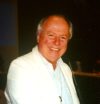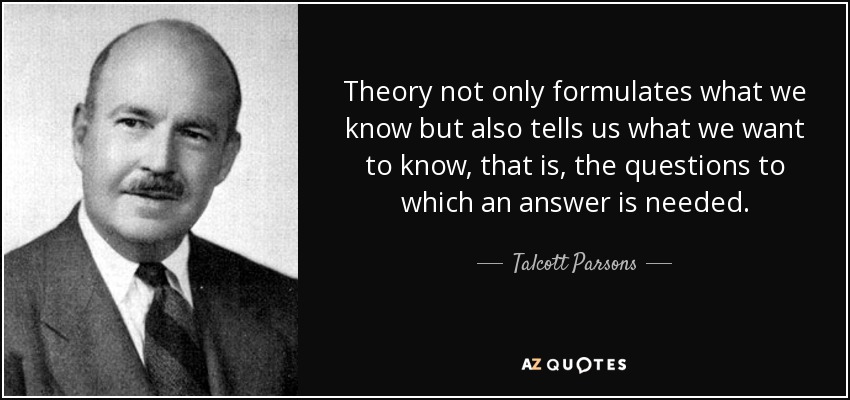Talcott Parsons (13 Dec 1902 – 8 May 1979): The Promise of Transdisciplinarity
BIOGRAPHIES, 11 Dec 2017
Rene Wadlow – TRANSCEND Media Service
Talcott Parsons was a leading US sociologist usually considered a member of the structural-functional analysis school. Some of his major theoretical writings are The Structure of Social Action (New York: McGraw-Hill, 1937), Essays in Sociological Theory Pure and Applied (Glencoe, The Free Press, 1949), The Social System (Glencoe: The Free Press, 1951), and Talcott Parsons and Edward Shils (Editors). Toward a General Theory of Action (Cambridge, MA: Harvard University Press, 1954). Parsons taught at Harvard University and was the doctoral thesis advisor of students who went on to became important figures in the same tradition such as Robert K. Merton Social Theory and Social Structure (Glencoe: The Free Press, 1949), Marion J. Levy Jr The Structure of Society (Princeton: Princeton University Press, 1952) and Clifford Geertz The Interpretation of Cultures (New York: Basic Books, 1973). He also had students who went on to have radically different approaches and who became strong critics of Parsons’ approach such as C. Wright Mills in his The Sociological Imagination (New York: Oxford University Press, 1959). Parsons’ approach was also attacked by George Gurvitch (1894-1965) a Russian-born French sociologist who spent the Second World War years in New York City and became knowledgeable with the schools of US sociology.
There are two aspects of Parsons’ work that merit attention. The first is the role of Parsons in introducing and championing the work of the German sociologist Max Weber in the USA. The second is the role of Parsons in helping create transdisciplinarity in area studies in the USA.
Parsons was unusual for his time in that he did all his graduate university studies in Europe. Many American students would spend a year at a European university but because of differences in degree programs would do their degree work within a US university. However, Parsons did his MA at the London School of Economics and his doctorate at the University of Heidelberg. In London, he studied under R.H. Tawney who was interested in the link between Calvinist Protestant thought and the development of capitalism. This was a topic of great interest to Parsons who came from a long line of Calvinist ministers who had gone from England to New England in search of religious liberty in the late 1600s. Parsons’ father was a Protestant minister as well as president of a University, and Parsons kept a life-long interest in liberal Protestant theology. In London, he also participated in a seminar led by the anthropologist Bronislaw Malinowski in which also participated as students E.E. Evans-Pritchard and Meyer Fortes who went on to be the leading British anthropologists on African societies. Parsons always kept an interest in anthropology and some of his students went on to be professional anthropologists.
In Heidelberg, he studied under Alfred Weber (Max Weber’s brother) and got to know the widow of Max Weber who was a champion of Max Weber’s thought. Parsons was taken by Max Weber’s thinking, especially the analysis of the link between religious thought and economic organization. When Parsons returned to the USA, he started translating Weber and then getting his colleagues like Edward Shils and his students like C. Wright Mills to translate works of Weber. Thus Max Weber went from being virtually unknown in the USA to being probably the most-often quoted sociologist in the USA.
After his doctorate, Parsons went to teach at Harvard, which is a leading New England University. In 1931, sociology which had always been taught in the Department of Social Ethics became the basis for a new three-man Department of Sociology with the Russian-born Sociologist Pitrim Sorokin as chairman. Sorokin and Parsons did not get along; both men had a high opinion of his own work, little tolerance for the work of others, and no sense of humor. Parsons, who was always very good at university administration infighting was able to have created a new Department of Social Relations with himself as chair. There he was able to develop a transdiciplinary approach by bringing in people from economics, anthropology, and psychology. By the late 1930s Parsons had become very interested in the work of S. Freud and was trained and underwent analysis at the Boston Psychoanalytic Institute.
One of the important ideas that Parsons had drawn from Max Weber was the idea of the “ethic of responsibility”. What distinguishes responsibility from merely good intentions is the ability to foresee as far as possible the consequences of action and to make decisions based on this foresight. Thus, Parsons from his years of study in Germany continued to follow closely political evolution there. He was a “premature” anti-Nazi and helped find jobs in US universities for German professors forced out of teaching by the Nazi government. At Harvard, he set up a working group on the study of Germany in order to understand how the Nazis had come to power. During the war, the group was transformed into a group to study what should be done after the war and to train people for the occupation of Germany which was to follow.
Likewise, as the US entered the war against Japan, Parsons organized working groups to study the societies of Japan and China. While there had been people who specialized in the arts of the Far East in US universities, the study of the structure of their societies was largely unknown. Harvard became a leading center for the study of Japan and China. To his credit, Parsons continued his interest in Japan after the end of the war. One of the last things he did before his death was a lecture tour of Japanese universities.
With his responsibility for training people for the occupation of Germany, he had gone back several times to Germany to interview and to help set up sociological studies. During these trips he had interviewed Soviet prisoners who had been members of the anti-Stalinist Vlasov movement — what some have called ‘Stalinists without Stalin’. Parsons felt that relations with the Soviet Union would go from bad to worse and that Americans had little knowledge of Russian society. Thus he pushed for the creation of a Soviet/Russian studies program at Harvard which became a leading center for Russian studies in the USA.
Parsons died in 1979 on a trip to Germany to celebrate the 50th anniversary of his Heidelberg degree. While he had a difficult personality and relations with people who did not agree with him were often tense or broken off when Parsons realized that the other could not be converted, he did make important contributions to the study of society with his emphasis on a “theory of action”. Most important, I believe, was his ability to create working groups focused on crucial world areas with a transdisciplinary approach which acknowledges that there is no hierarchy of research disciplines. Rather transdisciplinarity transgresses these boundaries to provide original and creative outcomes.
____________________________________________
 René Wadlow is a member of the Fellowship of Reconciliation’s Task Force on the Middle East, president and U.N. representative (Geneva) of the Association of World Citizens, and editor of Transnational Perspectives. He is a member of the TRANSCEND Network for Peace Development Environment.
René Wadlow is a member of the Fellowship of Reconciliation’s Task Force on the Middle East, president and U.N. representative (Geneva) of the Association of World Citizens, and editor of Transnational Perspectives. He is a member of the TRANSCEND Network for Peace Development Environment.
This article originally appeared on Transcend Media Service (TMS) on 11 Dec 2017.
Anticopyright: Editorials and articles originated on TMS may be freely reprinted, disseminated, translated and used as background material, provided an acknowledgement and link to the source, TMS: Talcott Parsons (13 Dec 1902 – 8 May 1979): The Promise of Transdisciplinarity, is included. Thank you.
If you enjoyed this article, please donate to TMS to join the growing list of TMS Supporters.

This work is licensed under a CC BY-NC 4.0 License.
